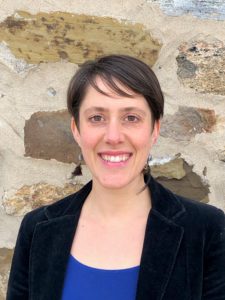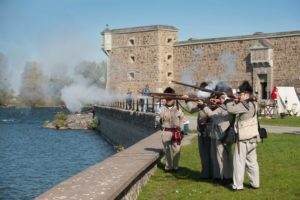Interview: Annie-Claude Beaudry, Parks Canada
Annie-Claude Beaudry works at Parks Canada as the event coordinator of the Mauricie and Western Quebec field unit. She is now acting manager for the Fort-Chambly, Fort-Lennox and Louis-S. St-Laurent National Historic Sites.
Interview
Annie-Claude Beaudry, Parks Canada
With over 10 years of experience in special events and community relationships, Annie-Claude brings both creativity and comprehensive project management expertise to the teams she manages.

01. Tell us about your greatest success of an event that increased the awareness of your historic place.
One of our best events is the Feast of St. Louis which is held in August. It’s a two-day festival held both outside in the park and inside Fort Chambly National Historic Site itself. The festival is hosted jointly with the City of Chambly who run an art symposium, “Artistes sur le champ”, on the site at the same time. The art festival is well known in the region and brings more than 50 artists together who sell paintings and other artistic works. Parks Canada hosts special programming for the event such as roaming animators, demonstrations, music and re-enactments. The event is a great success attracting around 10,000 visitors over the weekend.

Fort Chambly National Historic Site
02. What do you think made it such a success?
It’s a collaboration between Parks Canada and a well-known art symposium, joining forces for a mutual benefit. The event caters to a diverse audience and brings a lot of people inside the fort.
Because the event is a tight collaboration between the city and us, we’ve created a joint flyer that informs visitors of all the programming happening whether at the artist festival or inside the fort. We have special activities like a firing historical weapons demonstration and food. Programming changes slightly every year.
03. How did you determine who to target with your marketing?
We analyzed who is already coming to the fort using postal codes, then we analyzed who lives in the region. We have information from our social science team at Parks Canada and they tell us who lives in the neighbourhood. Without forgetting our natural audience who are older couples or individuals who love history, we want to convince more families to visit and to come back. Mostly we get first time visitors so, we decided to target repeat visitors and encourage people to come back – families and people who live close.
We also target people who will bring friends, families, visitors.
04. How were you able to continue to engage your community?
To engage our community, we needed to create an attractive program and we did this by changing a part of our exhibition. A few of our rooms are now dedicated to temporary exhibitions: we change the theme, or topic, every three years. And with these new temporary exhibitions, we renew the activities for the whole site. With the redone space come new ideas, a new way to present our mandate, our messages and key messages. For example, the first year we created a temporary exhibition called “Saveurs de la Nouvelle-France,” a taste of New France. For this exhibition, we converted our outside space into a vegetable garden. This year we changed our theme to Smuggling in New France. For this exhibition, we changed the same outdoor space to a natural forest, and we talk more about the importance of the territory, how we had to use the resources in the woods to survive. The smugglers passed by the fort by the water, but also, they had to sneak through the woods. The changing exhibition provides a tone for the whole visitor experience. We don’t have the resources to rebuild the whole exhibition inside the fort but with a new theme, we can keep our activities fresh.
05. What advice would you give a small team planning for the first time an event for a historic place?
- First, know your target audience, who you aim to reach and who is already visiting your site.
- Look at what is missing in the neighbourhood. Be sure you are not offering something that already exists in the community.
- Analyze who could be your ally or collaborator. Who could be your partner? Is there an event that you could work with?
- And to make people stay longer, it’s good to offer something to eat and a family space to relax where people can sit, breastfeed, play freely, etc.. Even if it’s simple, it doesn’t need to cost much.
At historic places, we want people to learn but we also want them to feel free to stay to enjoy the place.